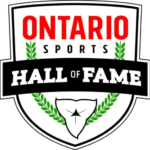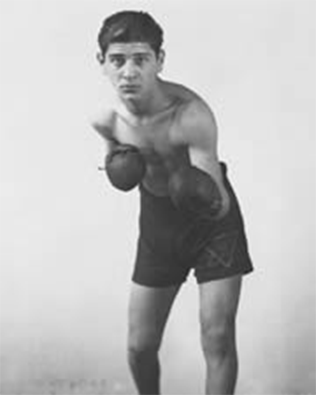Sammy Luftspring was a Jewish Canadian boxer. A former Canadian Welterweight Champion and highly ranked in the Welterweight class during his career, Luftspring was forced to retire from the sport due to an eye injury. He was inducted into Canada’s Sports Hall of Fame in 1985.
Luftspring was born and raised in a low class residential area of Toronto. It was home to many Eastern European (primarily Jewish) and Italian immigrants. He began his boxing career in 1932 out of Brunswick Talmud Torah, a local Toronto Jewish community and recreational centre. Throughout his career, he wore a Magen David on his trunks. Over the next four years, he fought 105 times (attaining a record of 100-5) and captured Golden Gloves Tournaments in various weight classes ranging from bantamweight to welterweight.
By 1933, he was the Ontario amateur lightweight champion and regarded as one of the best amateur boxing talents.
In 1933, Luftspring was involved in the infamous Toronto Christie Pits Riots. A riot occurred at Christie Pits Park following tensions that occurred during a series of amateur softball games. Fighting broke out between a group of young Jewish and Italian men and the local Swastika Club, a group of Canadian Nazi sympathizers.
1936 Berlin Olympics Boycott
Luftspring was named to Canada’s Olympic team for the 1936 Berlin Olympics. At the encouragement of his parents, he refused to attend the Games in protest over the poor treatment Jews were receiving in Nazi Germany. He made his views on the subject public in a letter to the Toronto Globe. In the letter, he protested that “the German government was treating its Jewish brothers and sisters worse than dogs”. He even went as far as to say that “the German government would exterminate Jews if they had the opportunity”. Luftspring and another boxer, Norman “Baby” Yak, attempted to participate in an alternate event being hosted that summer, the People’s Olympics in Barcelona, Spain. The Spanish Civil War broke out prior to the Games’ opening ceremonies. The event caused the cancellation of the People’s Olympics. By the time Luftspring found out about the cancellation, he had already reached Dieppe, France. Luftspring, disappointed at not having a chance to compete, returned to Toronto.
Professional career
Luftspring began to box professionally in the fall of 1936. A year later, he fought Gordon Wallace for the Canadian welterweight championship. He lost to Wallace in a 10-round decision.
In 1938, Luftspring knocked out Frank Genovese in the 13th round to win the Canadian welterweight championship. This was Ontario’s first-ever scheduled 15-round fight. Luftspring held the Canadian title for two years. That title fight was one of four times Luftspring defeated Genovese in his career. Their rivalry was extremely competitive and one of the dominant storylines of Toronto boxing in the late 1930s. That same year, he was ranked the number three welterweight boxer in the world. He was subsequently offered a chance to fight world champion Henry Armstrong in 1940. In a fight in New York against Steve Belloise, Luftspring was injured. He was thumbed in the eye. The medical diagnosis was a detached retina resulting in significant loss of vision in the eye. The fight was supposed to be a tune up for the championship bout against Armstrong. Luftspring was forced to quit boxing.
Details of his career record are unclear. Different reports have him winning 50 of either 55 or 56 pro bouts. More detailed records list him as 32-8 with 14 knockouts.



